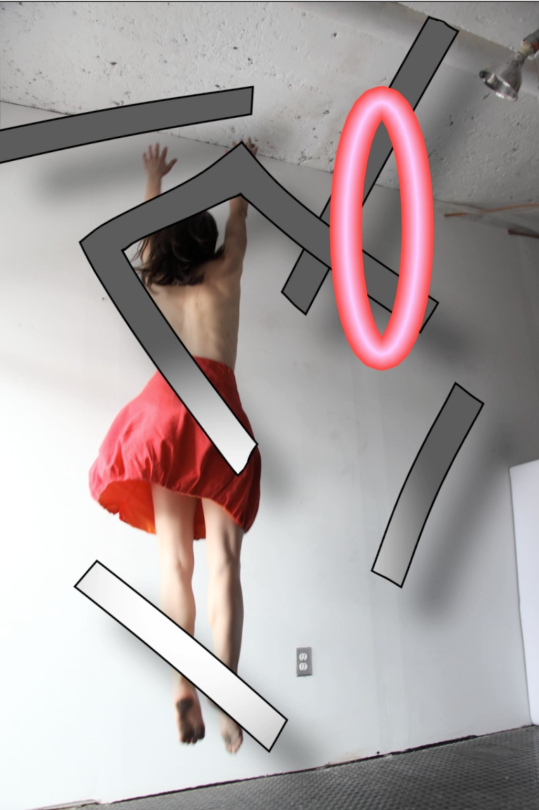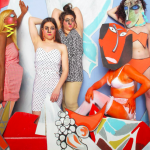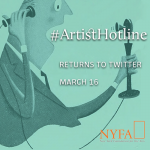IAP Interview: Eva Davidova and Haisi Hu
“I know that being an immigrant definitely changed me. It is not obvious, it’s on the inside.”
On a warm night last summer, Immigrant Artists Program (IAP) participants and artists Haisi Hu and Eva Davidova participated in a little impromptu “sidewalk astronomy” during one of their IAP meetings and ended up in a New York Times article. Just one of the many things that can happen during a mentor/mentee meeting. NYFA has spoken to both of them about their experiences as immigrant artists in New York.
IAP Mentor Haisi Hu is a stop motion animator and a media, film and video artist. Haisi is originally from China and has been living in New York for more than 20 years.
Mentee Eva Davidova hails from Bulgaria and moved to Spain as a teenager, where she also started her career. Eva then moved to London and had the chance to go to New York, instantly loving the city which she has called home for ten years now.
NYFA: Do you remember your very first impression of New York and America?
Eva Davidova (ED): I remember crossing the Verrazano Bridge. I was coming up from Virginia in a car packed with people playing country music and it was January or February. As we were crossing the bridge, there was an amazing sunset and all of New York was in a strange fog. You could only see half of the buildings because the tops of the buildings were hidden. I remember the first days walking through New York and loving the presence of it. The city itself just made me fall in love immediately.
NYFA: How about yourself Haisi? Do you remember something vividly?
Haisi Hu (HH): Yes! When I first came I was a teenager and I went to high school and I was really depressed. At first I came to Brooklyn, so I wasn’t really in the city. My family lived close to Coney Island. That’s where I went to high school. Coming from China you think you are going to New York and it is this grand thing but it is not. Brooklyn is different. All the projects and the color of the whole landscape is just so grey. Then you go to the Metropolitan Museum. That was the first place my family took me to. It just blew my mind how beautiful this place was and the discrepancy of it. It is like a dream place only rich people can go to and then we just stayed in Brooklyn. I hated Brooklyn as a teenager. I thought it was a ghetto and Manhattan was the place where people were successful. So, there really was a deep sense of segregation, which I experienced. I had never experienced this before. There was also the sense of discrimination. There were times when I felt like I was not treated fairly because I was an immigrant.
NYFA: Has being an immigrant influenced your arts practice?
HH: I don’t know. There are two types of artists I noticed. A lot of my Chinese friends did a lot of art that is very politically related to China, showing the Chinese culture in America. I don’t think I am that type of artist. I think my art does not reveal my background. However, I know that being an immigrant definitely changed me. It is not obvious, it’s on the inside. I have been told by a lot of people I am a hybrid. There are all these parts in me but it is absorbed and integrated rather than there being separate presentations.
ED: I am a lot like Haisi in this sense. I also remember when I first came here I noticed all the different cultures, different people and the separation. It made me think of a project called “Beautiful Protection” which was about protecting space while inviting people in at the same time. Someone also once said that all artists are outsiders. Even in Bulgaria I felt the separation at times. In New York I have felt more at home maybe because there are more people like me who are from different backgrounds. But I have used the memory of Bulgaria in my artwork. The political situation there before and after the wall came down mixed up with childhood ideas are in at least one or two projects. I loved the result but it is something that comes in waves. I don’t force it. I don’t insist on it.

NYFA: What do you think is your most pronounced Americanism or American behavior that you have picked up?
ED: For me there is a difference between the Americanization and the “New Yorkization.” I’ve never heard anyone say ‘you’ve become so American’ except when I am very punctual. I used to be very bad at that and couldn’t get anywhere on time. Now they say ‘you’ve become American. You are on time!’. With the huge distances in the city, it is so difficult to arrange to meet someone or see something. If people weren’t punctual it would be a mess.
HH: I feel like when I was growing up in New York I was told that people don’t need your opinion or your criticisms. In China we are very outspoken. Sometimes it is good and sometimes it is bad but people are very critical of each other. It is a very tight community. Therefore gossip is important. What the communities say about you is very important. But here there is definitely more emphasis on individual freedom that you are free to do what you want to do and that it is nobody’s business. The individual’s rights are much more pronounced and much more respected here.
ED: One more thing that may be more related to my practice is that in Europe in general, especially in Bulgaria, in Spain probably as well, it’s considered to be bad taste to talk about your artwork and kind of highlight what you’ve done well, to praise yourself. This is something which is very hard for me. I think I have gradually changed to talk more about what I’m doing, how I am doing, maybe sometimes I force it even just to see what happens.
HH: Here it is more pushy. Especially being an artist pushes you more to present your work proudly and say “this is my achievement”. It is something that could definitely not be accepted in China. There was this famous animator, who on the first day of an event came out to speak and said “Oh, my work is terrible, I am horrible to present this worthless thing”. But that is the conventional way to speak about yourself in China. You have to bring yourself really low instead of just saying “hey, this is great work”.
ED: Yes, it is similar in Bulgaria. You have to be humble, talk little.
NYFA: What do you miss most about home? What do you miss most about China and Bulgaria?
ED: What I miss most about Bulgaria are feelings from my childhood. I miss my childhood. I miss certain sensations and I miss the disapprobation of money. Money was not really an issue in my childhood. I mean, there was no money, it was similar to China. From Spain, I miss my family and friends and the quality of life. Actually I have been thinking about how much aesthetics can help the society as a whole in day-to-day living. If you’re looking at so many things here, like Haisi was saying earlier, Brooklyn was ugly. I think in Europe, in Spain, there is still this sense of making everything around the family, the people, bars a little bit more livable and enjoyable for the immediate sense. It is more sensual in a way. I think here, it is very passionate, rational, strong, powerful, there is extreme beauty and extreme ugliness but the sensuality of Europe is what I sometimes miss. Why can’t I walk down the street and feel that way? In Europe I can get in a car and drive in every direction where I will always end up seeing something pretty.
HH: Unfortunately, in much of New York, the architecture is lacking some sense of romance. In Europe even in the poor neighborhoods there is some sense of romance and nostalgia. Especially as a filmmaker you can almost just go anywhere in Europe, shoot some scenes and it will look cinematic because there is poetry in the landscape. In New York there is dryness, there is a lack of color. Things are very flat. There is almost no space. It is functional.
Eva Davidova is showing four animations at the video exhibition “Look at me! I am made for you” at Projektraum LS43 in Berlin through March 2016, and in May 2016 she will attend the Neo Future Artist Residency at Arteles, Finland.
For more information on the Immigrant Artist Mentoring Program click here and to sign up to the monthly Con Edison IAP Newsletter to receive opportunities and events as well as artist features directly into your inbox, click here.
– Mara Vlatkovic, Digital Communications Officer
Images, from top: Haisi Hu (left) and Eva Davidova (right), photo credit: Mara Vlatkovic; Eva Davidova (IAP ‘15), Still from Untitled (casa Curruchet), 2015





